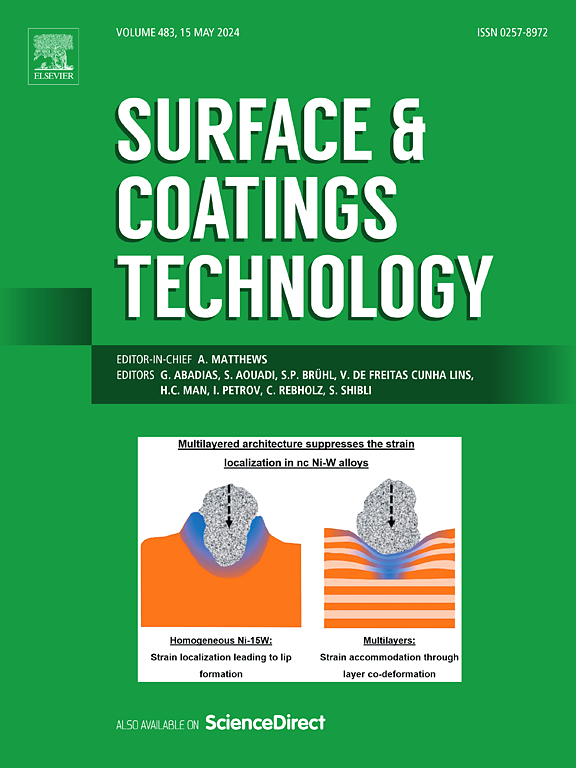Effect of Nb content on microstructure and tribological properties of AlCrMoNbxNi high-entropy alloy coatings
IF 5.3
2区 材料科学
Q1 MATERIALS SCIENCE, COATINGS & FILMS
引用次数: 0
Abstract
For the surface modification of M2 high-speed steel, incorporating Laves phases into high-entropy alloy (HEA) coatings offers an innovative strategy to enhance hardness and wear resistance. In this study, a series of AlCrMoNbxNi (x = 0, 0.25, 0.5, 0.75, and 1) HEA coatings were successfully fabricated via laser cladding. The effects of Nb content on microstructural evolution, mechanical properties, and tribological performance were systematically investigated. The addition of Nb promotes the precipitation of an Fe2Nb-type hexagonal close-packed (HCP) Laves phase, leading to a coating microstructure dominated by body-centered cubic (BCC), B2, and Laves phases. Among the investigated coatings, the Nb0.25 coating exhibited the best tribological performance, with the lowest friction coefficient of 0.63 and wear rate of 1.49 × 10−5 mm3/N·m. Its wear resistance was approximately 2.21 times greater than that of the M2 steel substrate. The superior performance of the Nb0.25 coating originates from four key factors: First, the elliptical and needle-shaped Laves phases formed in the coating are uniformly dispersed within the BCC matrix, collectively contributing to a substantial precipitation strengthening effect. Second, the optimal ratio of Laves phases to the BCC matrix allows the coating to achieve a desirable balance between strength and ductility. Additionally, a portion of Nb is dissolved into the BCC matrix, contributing to solid-solution strengthening. Finally, the primary wear mechanism of the coating is oxidative wear, and the oxide film formed during friction effectively minimizes material loss.

Nb含量对AlCrMoNbxNi高熵合金涂层组织和摩擦学性能的影响
对于M2高速钢的表面改性,在高熵合金(HEA)涂层中加入Laves相提供了一种提高硬度和耐磨性的创新策略。在本研究中,通过激光熔覆制备了一系列AlCrMoNbxNi (x = 0、0.25、0.5、0.75和1)HEA涂层。系统研究了铌含量对合金微观组织演变、力学性能和摩擦学性能的影响。Nb的加入促进了fe2nb型六方密排(HCP) Laves相的析出,导致涂层组织以体心立方(BCC)、B2和Laves相为主。其中,Nb0.25涂层的摩擦学性能最好,摩擦系数最低,为0.63,磨损率为1.49 × 10−5 mm3/N·m。其耐磨性约为M2钢基体的2.21倍。Nb0.25涂层的优异性能源于四个关键因素:首先,涂层中形成的椭圆状和针状Laves相均匀地分散在BCC基体中,共同促进了显著的沉淀强化效果。其次,Laves相与BCC基体的最佳比例允许涂层在强度和延展性之间达到理想的平衡。此外,一部分Nb溶解到BCC基体中,有助于固溶强化。最后,涂层的主要磨损机制是氧化磨损,在摩擦过程中形成的氧化膜有效地减少了材料的损失。
本文章由计算机程序翻译,如有差异,请以英文原文为准。
求助全文
约1分钟内获得全文
求助全文
来源期刊

Surface & Coatings Technology
工程技术-材料科学:膜
CiteScore
10.00
自引率
11.10%
发文量
921
审稿时长
19 days
期刊介绍:
Surface and Coatings Technology is an international archival journal publishing scientific papers on significant developments in surface and interface engineering to modify and improve the surface properties of materials for protection in demanding contact conditions or aggressive environments, or for enhanced functional performance. Contributions range from original scientific articles concerned with fundamental and applied aspects of research or direct applications of metallic, inorganic, organic and composite coatings, to invited reviews of current technology in specific areas. Papers submitted to this journal are expected to be in line with the following aspects in processes, and properties/performance:
A. Processes: Physical and chemical vapour deposition techniques, thermal and plasma spraying, surface modification by directed energy techniques such as ion, electron and laser beams, thermo-chemical treatment, wet chemical and electrochemical processes such as plating, sol-gel coating, anodization, plasma electrolytic oxidation, etc., but excluding painting.
B. Properties/performance: friction performance, wear resistance (e.g., abrasion, erosion, fretting, etc), corrosion and oxidation resistance, thermal protection, diffusion resistance, hydrophilicity/hydrophobicity, and properties relevant to smart materials behaviour and enhanced multifunctional performance for environmental, energy and medical applications, but excluding device aspects.
 求助内容:
求助内容: 应助结果提醒方式:
应助结果提醒方式:


